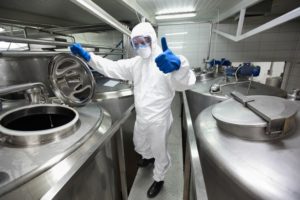
Aluminum is considered by most government health authorities perfectly acceptable to eat, wear as an antiperspirant, and inject into your body as a vaccine ingredient, but research indicates it has cancer-causing properties, even at levels 100,000 times lower than found in certain consumer products.
A concerning study published in the Journal of Inorganic Biochemistry demonstrates clearly that exposure to aluminum can increase migratory and invasive properties of human breast cancer cells. This has extremely important implications, because mortality from breast cancer is caused by the active spread of the tumor and not from the presence of the primary tumor in the breast itself. This profound difference, in fact, is why a groundbreaking National Cancer Institute commissioned expert panelrecently called for the complete reclassification of some types of non-progressive ‘breast cancer’ and ‘prostate cancer’ as essentially benign lesions – bittersweet news for the millions who were already misdiagnosed/overdiagnosed and mistreated/overtreated for ‘cancer’ over the past 30 years.
Another recent relevant study, also published in the Journal of Inorganic Biochemistry, found increased levels of aluminum in noninvasively collected nipple aspirate fluids from 19 breast cancer patients compared with 16 healthy control subjects. The researchers commented on their findings: “In addition to emerging evidence, our results support the possible involvement of aluminium ions in oxidative and inflammatory status perturbations of breast cancer microenvironment, suggesting aluminium accumulation in breast microenvironment as a possible risk factor for oxidative/inflammatory phenotype of breast cells.”[1]
A key implication of this research is that the common ingestion (food additive), injection (as a vaccine adjuvant), and topical application (antiperspirant) of forms of aluminum may be contributing to the burgeoning cancer epidemic in exposed populations. Given this possibility, the further use of aluminum in foods, cosmetics and drugs should be halted until adequate risk assessments can be made thoroughly proving its safety. (Since we do not use the precautionary principle to guide risk assessments and their regulation in the US, instead opting for a chemical and drug-industry favoring “weight of evidence” standard, this likely will not happen; however, we can use this information to apply the precautionary principle in our own lives)
When it comes to aluminum’s presence in antiperspirant formulas, a very concerning study published last year in the Journal of Applied Toxicology identified the primary form of aluminum used in underarm cosmetics – aluminum chloride – as capable of altering breast cancer cells in a way indicative of ‘neoplastic transformation,’ or, the transformation of a healthy cell into a cancerous one:
“These results suggest that aluminium is not generically mutagenic, but similar to an activated oncogene [cancer-causing gene], it induces proliferation stress, DSBs and senescence in normal mammary epithelial cells; and that long-term exposure to AlCl(3) generates and selects for cells able to bypass p53/p21(Waf1) -mediated cellular senescence. Our observations do not formally identify aluminium as a breast carcinogen, but challenge the safety ascribed to its widespread use in underarm cosmetics.”
Even more concerning was their finding that these changes, which included “contact inhibition and anchorage-independent growth” (two markers of malignancy), were caused by concentrations “…up to 100 000-fold lower than those found in antiperspirants, and in the range of those recently measured in the human breast.”[2]
This nstudy dovetails with similar research demonstrating that aluminum binds to cellular estrogen receptors, indicating it may disrupt and/or drive proliferation within hormone-sensitive tissues. One research team coined a new term – “metalloestrogen” – to describe an entirely new class of metal-based endocrine disrupters, including aluminum, antimony, arsenite, barium, cadmium, chromium (Cr(II)), cobalt, copper, lead, mercury, nickel, selenite, tin and vanadate. This reclassification of what were formerly perceived to be hormonally inert substances should help to alert consumers to the significant health risk associated with the use of ‘unnatural’ products containing these elements.
While there is little extant animal research demonstrating aluminum’s cancer causing properties, which is why it has not yet been classified with respect to carcinogenicity, “aluminum production” has been classified as carcinogenic to humans by the International Agency for Research on Cancer (IARC).[3] There is also a 2011 study published in the Journal of Applied Toxicology that found aluminum content is higher in nipple aspirate fluid of breast cancer-affected women versus healthy controls.
Aluminum, of course, is widely distributed within our environment (reaching, at present, the highest level in documented history), and has even been implicated in atmospheric aerosols (i.e. geoengineering/ ‘chemtrails’); which, incidentally, may be one reason why our soils are becoming saturated with the metal to levels toxic to plants, and why biotech corporations are presently working on developing aluminum-tolerant GM plants. It has also been linked to the rapidly expanding epidemic of autism spectrum disorder diagnoses, as discussed in two previous articles:
Because our regulators consider aluminum perfectly ‘safe to eat,’apply topically, andinject into our bodies to “improve natural immunity,” the emerging view of aluminum as possessing cancer-causing effects will put additional responsibility on consumers to educate themselves and make choices to protect themselves from avoidable exposure.
Learn more about how to protect yourself against aluminum by reading the following articles:
- Is Eating and Injecting Aluminum Safe As Our Regulators Say?
- Can We Continue To Justify Injecting Aluminum Into Our Children?
REFERENCES
[1] F Mannello, D Ligi, M Canale. Aluminium, carbonyls and cytokines in human nipple aspirate fluids: Possible relationship between inflammation, oxidative stress and breast cancer microenvironment. J Inorg Biochem. 2013 Jul 12. Epub 2013 Jul 12. PMID: 23916117
[2] André-Pascal Sappino, Raphaële Buser, Laurence Lesne, Stefania Gimelli, Frédérique Béna, Dominique Belin, Stefano J Mandriota. Aluminium chloride promotes anchorage-independent growth in human mammary epithelial cells. J Appl Toxicol. 2012 Jan 6. Epub 2012 Jan 6. PMID: 22223356
[3] Daniel Krewski, Robert A Yokel, Evert Nieboer, David Borchelt, Joshua Cohen, Jean Harry, Sam Kacew, Joan Lindsay, Amal M Mahfouz, Virginie Rondeau. Human health risk assessment for aluminium, aluminium oxide, and aluminium hydroxide. J Toxicol Environ Health B Crit Rev. 2007 ;10 Suppl 1:1-269. PMID: 18085482
Originally publishe: 2013-09-04
Article updated: 2019-06-11


